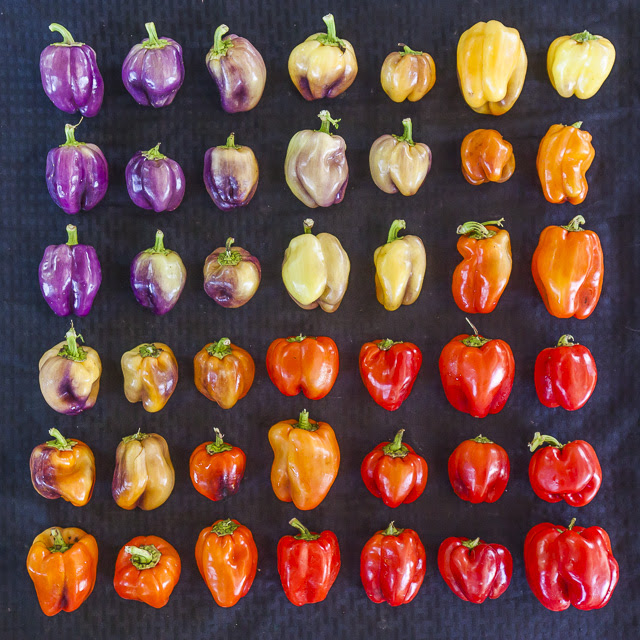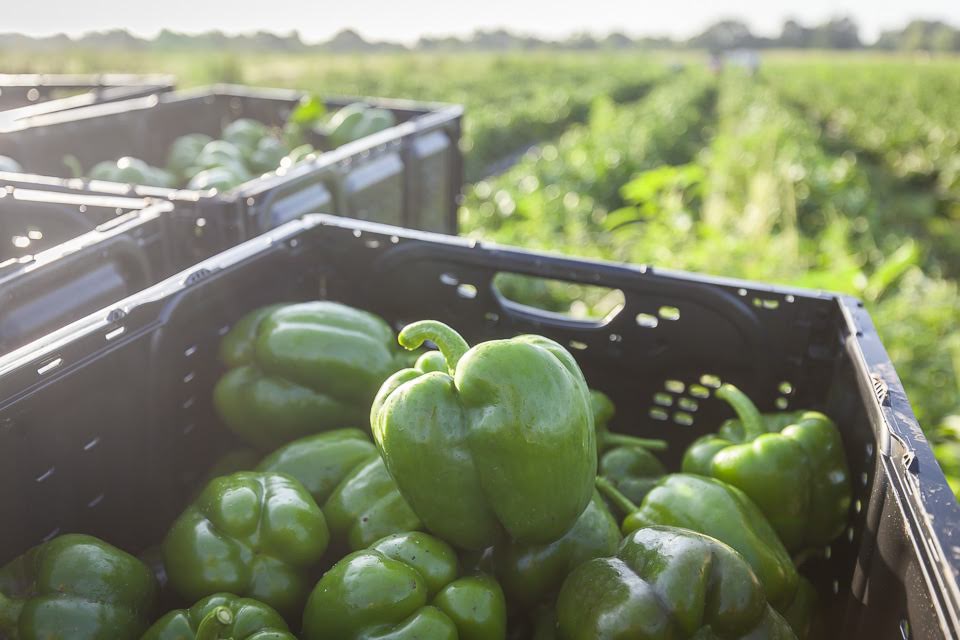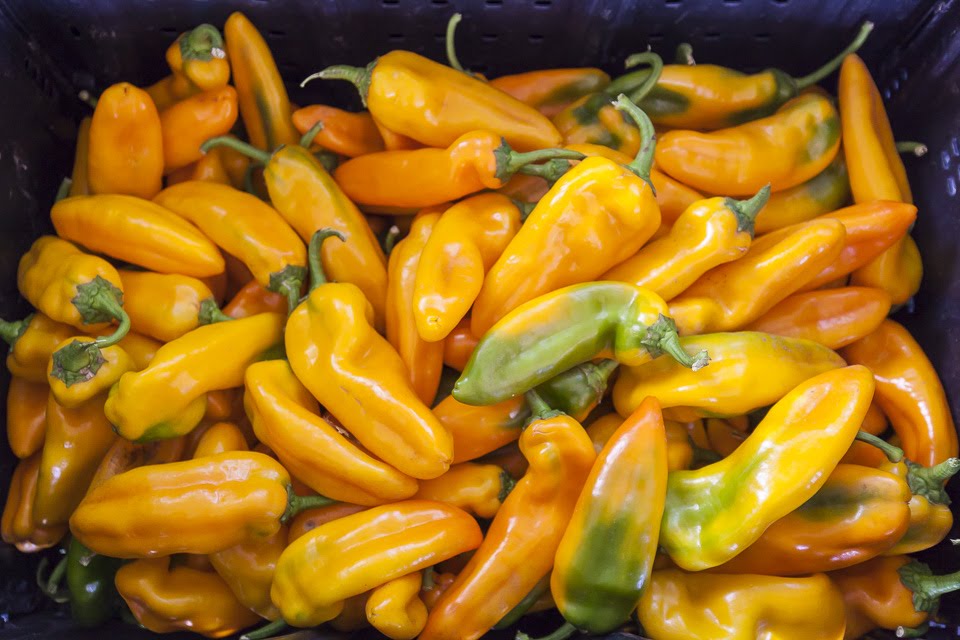
THE MERITS OF SWEET PEPPERS
07/31/20 — Ada Broussard
If you’re a CSA Member, you likely noticed the colorful assortment of sweet peppers scattered throughout your CSA box this week. We grow over 20 different varieties of peppers here at JBG, but this week we’re talking about those whose cell walls pack a sucrosey punch. Sweet peppers, members of the Capsicum family, can be crunched raw, like an apple, or incorporated into cooked dishes, providing a curtain of candy-like caramelization sweetening every bite. Peppers of all varieties are measured by Scoville heat units or SHUs. Hot peppers like jalapeños (2500-8000 SHUs) and habaneros (100,000-350,000 SHUs) aren’t the crop we care about today, and instead we’re just talking about the sweeties that adorn our fields: bell peppers (0-100 SHUs), banana peppers (1-500 SHU) and red and yellow Italian sweet peppers (0-500).
![]()
Sweet peppers are special not only because they are...sweet… but also because they survived the summer, despite the odds. You see, sweet peppers (often yellow, red, or orange in color) all start off as green. Green bell peppers, for example, are just the early, young, version of their red and yellow successors. It’s easy to harvest a pepper when it’s green - it hasn’t spent much time on the plant, and has thus avoided sun and pest damage. It’s more economical for farmers’ to harvest peppers early because each day the fruit sits on the plant, the more labor it takes to tend to the crop. But, what would a southern summer be without sweet peppers?
It may seem like we’re overloading you with sweet peppers this week, but we’re working off the assumption that there’s no such thing as too much of a good thing. Surplus peppers can be diced, blanched, and frozen or roasted, peeled, and packed in olive oil. Your future self will thank you for the prep work and warm, sweet flavors ready to enhance any fall feast or winter stew.
![]()
HOW TO STORE: Store unwashed sweet (and spicy, if you’re wondering) peppers in a plastic bag, in the refrigerator. Wait to wash the peppers just before you’re going to use them. Peppers stored this way should last for at least 1 week, potentially longer if they’re green. Keeping peppers in a bag, in the fridge, will help keep the moisture in the pepper and prolong the crunch-factor. Green peppers will usually last a bit longer than red or yellow ones, so save the green ones for later and use the others first!
HOW TO COOK: Stuff em’, saute them, eat them raw dipped in hummus, or roast them slow. The ways to eat sweet peppers are truly endless; incorporating sweet peppers into your cooking is a simple way to add (natural) sugar to your dish, which, spoiler alert: make everything taste a little more delicious. Use sweet peppers as a background ingredient (for example: as a part of the Holy Trinity as seen in Creole and Cajun cuisine or the base of a stirfry) or highlight peppers as an all-star: pitted and then stuffed with cheese, or rice, or cheesy rice.
HOW TO PRESERVE: Peter Piper picked a peck of pickled peppers, and you can definitely do the same. Peppers can also be blanched and frozen, but can also be slowly cooked in olive oil and packed into jars. Sweet peppers can be made into a sweet jam, and then schmeared on crackers with a healthy dose of cream cheese. Make a double batch of salsa or tomato sauce with some of your sweet peppers, some now, and some for later.
![]()

Sweet peppers are special not only because they are...sweet… but also because they survived the summer, despite the odds. You see, sweet peppers (often yellow, red, or orange in color) all start off as green. Green bell peppers, for example, are just the early, young, version of their red and yellow successors. It’s easy to harvest a pepper when it’s green - it hasn’t spent much time on the plant, and has thus avoided sun and pest damage. It’s more economical for farmers’ to harvest peppers early because each day the fruit sits on the plant, the more labor it takes to tend to the crop. But, what would a southern summer be without sweet peppers?
It may seem like we’re overloading you with sweet peppers this week, but we’re working off the assumption that there’s no such thing as too much of a good thing. Surplus peppers can be diced, blanched, and frozen or roasted, peeled, and packed in olive oil. Your future self will thank you for the prep work and warm, sweet flavors ready to enhance any fall feast or winter stew.

HOW TO STORE: Store unwashed sweet (and spicy, if you’re wondering) peppers in a plastic bag, in the refrigerator. Wait to wash the peppers just before you’re going to use them. Peppers stored this way should last for at least 1 week, potentially longer if they’re green. Keeping peppers in a bag, in the fridge, will help keep the moisture in the pepper and prolong the crunch-factor. Green peppers will usually last a bit longer than red or yellow ones, so save the green ones for later and use the others first!
HOW TO COOK: Stuff em’, saute them, eat them raw dipped in hummus, or roast them slow. The ways to eat sweet peppers are truly endless; incorporating sweet peppers into your cooking is a simple way to add (natural) sugar to your dish, which, spoiler alert: make everything taste a little more delicious. Use sweet peppers as a background ingredient (for example: as a part of the Holy Trinity as seen in Creole and Cajun cuisine or the base of a stirfry) or highlight peppers as an all-star: pitted and then stuffed with cheese, or rice, or cheesy rice.
HOW TO PRESERVE: Peter Piper picked a peck of pickled peppers, and you can definitely do the same. Peppers can also be blanched and frozen, but can also be slowly cooked in olive oil and packed into jars. Sweet peppers can be made into a sweet jam, and then schmeared on crackers with a healthy dose of cream cheese. Make a double batch of salsa or tomato sauce with some of your sweet peppers, some now, and some for later.







 0 ITEMS IN CART
0 ITEMS IN CART 

